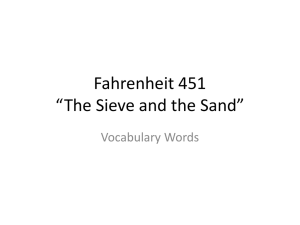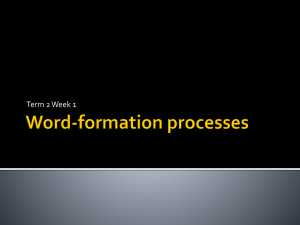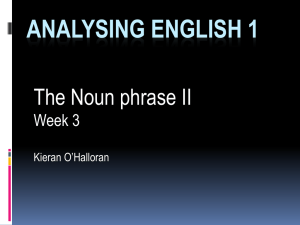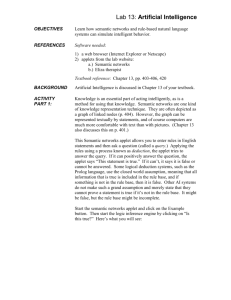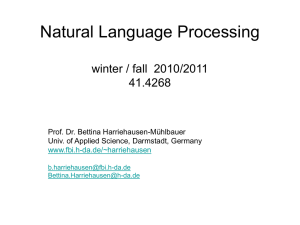eliza
advertisement
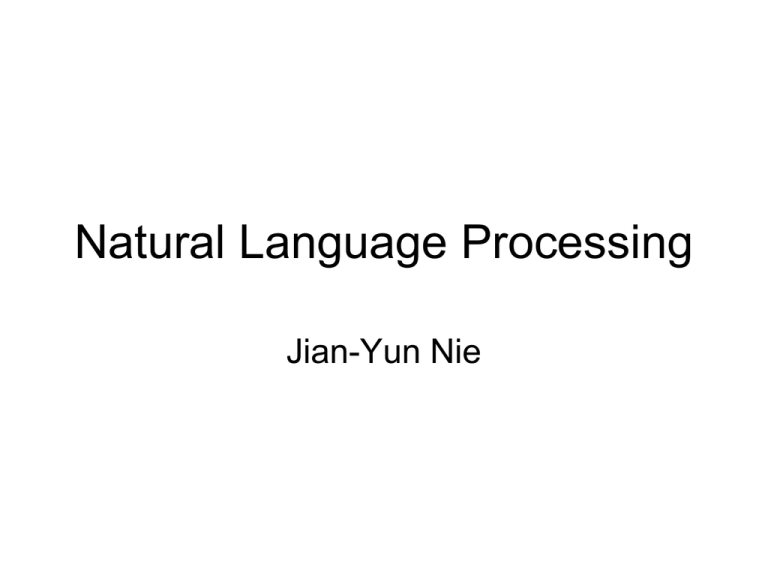
Natural Language Processing Jian-Yun Nie Aspects of language processing • Word, lexicon: lexical analysis – Morphology, word segmentation • Syntax – Sentence structure, phrase, grammar, … • Semantics – Meaning – Execute commands • Discourse analysis – Meaning of a text – Relationship between sentences (e.g. anaphora) Applications • • • • • • Detect new words Language learning Machine translation NL interface Information retrieval … Brief history • 1950s – Early MT: word translation + re-ordering – Chomsky’s Generative grammar – Bar-Hill’s argument • 1960-80s – Applications • • • • • • BASEBALL: use NL interface to search in a database on baseball games LUNAR: NL interface to search in Lunar ELIZA: simulation of conversation with a psychoanalyst SHREDLU: use NL to manipulate block world Message understanding: understand a newspaper article on terrorism Machine translation – Methods • • • • • ATN (augmented transition networks): extended context-free grammar Case grammar (agent, object, etc.) DCG – Definite Clause Grammar Dependency grammar: an element depends on another 1990s-now – – – – – Statistical methods Speech recognition MT systems Question-answering … Classical symbolic methods • Morphological analyzer • Parser (syntactic analysis) • Semantic analysis (transform into a logical form, semantic network, etc.) • Discourse analysis • Pragmatic analysis Morphological analysis • Goal: recognize the word and category • Using a dictionary: word + category • Input form (computed) • Morphological rules: Lemma + ed -> Lemma + e … (verb in past form) • Is Lemma in dict.? If yes, the transformation is possible • Form -> a set of possible lemmas Parsing (in DCG) s --> np, vp. np --> det, noun. np --> proper_noun. vp --> v, ng. vp --> v. Eg. john eats proper_noun v det -->[a]. det --> [an]. det --> [the]. noun --> [apple]. noun --> [orange]. proper_noun --> [john]. proper_noun --> [mary]. v --> [eats]. v --> [loves]. an apple. det np np vp s noun Semantic analysis john eats an proper_noun v det [person: john] λYλX eat(X,Y) apple. noun [apple] np [apple] np vp Sem. Cat (Ontology) object animated non-anim person animal food … [person: john] eat(X, [apple]) s fruit … eat([person: john], [apple]) vertebral … Parsing & semantic analysis • Rules: syntactic rules or semantic rules – What component can be combined with what component? – What is the result of the combination? • Categories – Syntactic categories: Verb, Noun, … – Semantic categories: Person, Fruit, Apple, … • Analyses – Recognize the category of an element – See how different elements can be combined into a sentence – Problem: The choice is often not unique Write a semantic analysis grammar S(pred(obj)) -> NP(obj) VP(pred) VP(pred(obj)) -> Verb(pred) NP(obj) NP(obj) -> Name(obj) Name(John) -> John Name(Mary) -> Mary Verb(λyλx Loves(x,y)) -> loves Discourse analysis • Anaphora He hits the car with a stone. It bounces back. • Understanding a text – Who/when/where/what … are involved in an event? – How to connect the semantic representations of different sentences? – What is the cause of an event and what is the consequence of an action? –… Pragmatic analysis • Practical usage of language: what a sentence means in practice – Do you have time? – How do you do? – It is too cold to go outside! –… Some success stories - ELIZA young woman: Men are all alike. eliza: In what way? young woman: They're always bugging us about something specific or other. eliza: Can you think of a specific example? young woman: Well, my boyfriend made me come here. eliza: Your boyfriend made you come here? young woman: He says I'm depressed much of the time. eliza: I am sorry to hear you are depressed. young woman: It's true. I'm unhappy. eliza: Do you think coming here will help you not to be unhappy? young woman: I need some help, that much seems certain. eliza: What would it mean to you if you got some help? young woman: Perhaps I could learn to get along with my mother. eliza: Tell me more about your family. young woman: My mother takes care of me. ELIZA – Cont’d eliza: Who else in your family takes care of you? young woman: My father. eliza: Your father. young woman: You are like my father in some ways. eliza: What resemblance do you see? young woman: You are not very aggressive but I think you don't want me to notice that. eliza: What makes you think I am not very aggressive? young woman: You don't argue with me. eliza: Why do you think I don't argue with you? young woman: You are afraid of me. eliza: Does it please you to believe I am afraid of you? young woman: My father is afraid of everybody. eliza: What else comes to mind when you think of your father? young woman: Bullies. eliza: Does that have anything to do with the fact that your boyfriend made you come here? Methods used in Eliza • Find a trigger in the input of the user (e.g. father) • Evoke a possible candidate pattern (e.g. family or mother) (~limited parsing) • Compose a sentence by filling in the slots of the pattern (picking some elements from the user input) • If no appropriate pattern is found, ask a general question, possibly related to the user input RACTER – poem and prose composer Slowly I dream of flying. I observe turnpikes and streets studded with bushes. Coldly my soaring widens my awareness. To guide myself I determinedly start to kill my pleasure during the time that hours and milliseconds pass away. Aid me in this and soaring is formidable, do not and singing is unhinged. *** Side and tumble and fall among The dead. Here and there Will be found a utensil. Success story – METEO Environment Canada • Generate and translate METEO forecasts automatically English<->French • Aujourd'hui, 26 novembre • Généralement nuageux. Vents du sud-ouest de 20 km/h avec rafales à 40 devenant légers cet après-midi. Températures stables près de plus 2. • Ce soir et cette nuit, 26 novembre • Nuageux. Neige débutant ce soir. Accumulation de 15 cm. Minimum zéro. • Today, 26 November • Mainly cloudy. Wind southwest 20 km/h gusting to 40 becoming light this afternoon. Temperature steady near plus 2. • Tonight, 26 November • Cloudy. Snow beginning this evening. Amount 15 cm. Low zero. Problems • Ambiguity – Lexical/morphological: change (V,N), training (V,N), even (ADJ, ADV) … – Syntactic: Helicopter powered by human flies – Semantic: He saw a man on the hill with a telescope. – Discourse: anaphora, … • Classical solution – Using a later analysis to solve ambiguity of an earlier step – Eg. He gives him the change. (change as verb does not work for parsing) He changes the place. (change as noun does not work for parsing) – However: He saw a man on the hill with a telescope. • Correct multiple parsings • Correct semantic interpretations -> semantic ambiguity • Use contextual information to disambiguate (does a sentence in the text mention that “He” holds a telescope?) Rules vs. statistics • Rules and categories do not fit a sentence equally – Some are more likely in a language than others – E.g. • hardcopy: noun or verb? – P(N | hardcopy) >> P(V | hardcopy) • the training … – P(N | training, Det) > P(V | training, Det) • Idea: use statistics to help Statistical analysis to help solve ambiguity • Choose the most likely solution solution* = argmax solution P(solution | word, context) e.g. argmax cat P(cat | word, context) argmax sem P(sem | word, context) Context varies largely (precedent work, following word, category of the precedent word, …) • How to obtain P(solution | word, context)? – Training corpus Statistical language modeling • Goal: create a statistical model so that one can calculate the probability of a sequence of tokens s = w , w ,…, w in a language. • General approach: 1 2 n s Training corpus Probabilities of the observed elements P(s) Prob. of a sequence of words P(s) P(w1 , w2 ,...wn ) P( w1 ) P(w2 | w1 )...P( wn | w1,n1 ) n P(wi | hi ) i 1 Elements to be estimated: P( w | h ) P(hi wi ) i i P(hi ) - If hi is too long, one cannot observe (hi, wi) in the training corpus, and (hi, wi) is hard generalize - Solution: limit the length of hi n-grams • Limit hi to n-1 preceding words Most used cases n – Uni-gram: – Bi-gram: – Tri-gram: P(s) P(wi ) i 1 n P(s) P(wi | wi 1 ) i 1 n P(s) P(wi | wi 2 wi 1 ) i 1 A simple example (corpus = 10 000 words, 10 000 bi-grams) wi I (10) P(wi) wi-1 wi-1wi P(wi|wi-1) 10/10 000 # (1000) (# I) (8) 8/1000 = 0.001 = 0.008 that (10) (that I) (2) 0.2 talk (8) 0.0008 I (10) (I talk) (2) 0.2 we (10) (we talk) (1) 0.1 … talks (8) 0.0008 he (5) (he talks) (2) 0.4 she (5) (she talks) (2) 0.4 … she (5) 0.0005 says (4) (she says) (2) 0.5 laughs (2) (she laughs) (1) 0.5 listens (2) (she listens) (2) 1.0 Uni-gram: P(I, talk) = P(I) * P(talk) = 0.001*0.0008 P(I, talks) = P(I) * P(talks) = 0.001*0.0008 Bi-gram: P(I, talk) = P(I | #) * P(talk | I) = 0.008*0.2 P(I, talks) = P(I | #) * P(talks | I) = 0.008*0 Estimation • History: short long modeling: coarse refined Estimation: easy difficult • Maximum likelihood estimation MLE # (wi ) P(wi ) | Cuni | # (hi wi ) P(hi wi ) | Cn gram | – If (hi mi) is not observed in training corpus, P(wi|hi)=0 – P(they, talk)=P(they|#) P(talk|they) = 0 • never observed (they talk) in training data – smoothing Smoothing • Goal: assign a low probability to words or n-grams not observed in the training corpus P MLE smoothed word Smoothing methods n-gram: • Change the freq. of occurrences – Laplace smoothing (add-one): | | 1 Padd _ one ( | C ) (| i | 1) i V – Good-Turing nr 1 change the freq. r to r* (r 1) nr nr = no. of n-grams of freq. r Smoothing (cont’d) • Combine a model with a lower-order model – Backoff (Katz) PGT ( wi | wi 1 ) PKatz ( wi | wi 1 ) ( wi 1 ) PKatz ( wi ) if | wi 1wi | 0 otherwise – Interpolation (Jelinek-Mercer) PJM (wi | wi 1 ) wi1 PML (wi | wi 1 ) (1 wi1 )PJM (wi ) Examples of utilization • Predict the next word – argmax w P(w | previous words) • Used in input (predict the next letter/word on cellphone) • Use in machine aided human translation – Source sentence – Already translated part – Predict the next translation word or phrase argmax w P(w | previous trans. words, source sent.) Quality of a statistical language model • Test a trained model on a test collection – Try to predict each word – The more precisely a model can predict the words, the better is the model • Perplexity (the lower, the better) – Given P(wi) and a test text of length N Perplexity = 2 1 N N ålog2 P(wi ) i=1 – Harmonic mean of probability – At each word, how many choices does the model propose? • Perplexity=32 ~ 32 words could fit this position State of the art • Sufficient training data – The longer is n (n-gram), the lower is perplexity • Limited data – When n is too large, perplexity decreases – Data sparseness (sparsity) • In many NLP researches, one uses 5-grams or 6-grams • Google books n-gram (up to 5grams)https://books.google.com/ngrams More than predicting words • Speech recognition – Training corpus = signals + words – probabilities: P(signal|word), P(word2|word1) – Utilization: signals sequence of words • Statistical tagging – Training corpus = words + tags (n, v) – Probabilities: P(word|tag), P(tag2|tag1) – Utilization: sentence sequence of tags Example of utilization • Speech recognition (simplified) argmaxw1, …, wn P(w1, …, wn|s1, …, sn) = argmaxw1, …, wn P(s1, …, sn|w1, …, wn) * P(w1, …, wn) = argmaxw1, …, wn I P(si|w1, …, wn)*P(wi|wi-1) = argmaxw1, …, wn I P(si|wi)*P(wi|wi-1) – Argmax - Viterbi search – probabilities: • P(signal|word), P(*** | ice-cream)=P(*** | I scream)=0.8; • P(word2 | word1) P(ice-cream | eat) > P(I scream | eat) – Input speech signals s1, s2, …, sn • I eat ice-cream. > I eat I scream. Example of utilization • Statistical tagging – Training corpus = word + tag (e.g. Penn Tree Bank) – For w1, …, wn: argmaxtag1, …, tagn I P(wi|tagi)*P(tagi|tagi-1) – probabilities: • P(word|tag) P(change|noun)=0.01, P(change|verb)=0.015; • P(tag2|tag1) P(noun|det) >> P(verb|det) – Input words: w1, …, wn • I give him the change. pronoun verb pronoun det noun > pronoun verb pronoun det verb Some improvements of the model • Class model – Instead of estimating P(w2|w1), estimate P(w2|Class1) – P(me|take) v.s. P(me|Verb) – More general model – Less data sparseness problem • Skip model – Instead of P(wi|wi-1), allow P(wi|wi-k) – Allow to consider longer dependence State of the art on POS-tagging • POS = Part of speech (syntactic category) • Statistical methods • Training based on annotated corpus (text with tags annotated manually) – Penn Treebank: a set of texts with manual annotations http://www.cis.upenn.edu/~treebank/ Penn Treebank • One can learn: – – – – P(wi) P(Tag | wi), P(wi | Tag) P(Tag2 | Tag1), P(Tag3 | Tag1,Tag2) … State of the art of MT • Vauquois triangle (simplified) concept semantic syntax word Source language semantic syntax word Target language Triangle of Vauguois State of the art of MT (cont’d) • General approach: – Word / term: dictionary – Phrase – Syntax – Limited “semantics” to solve common ambiguities • Typical example: Systran Word/term level • Choose one translation word • Sometimes, use context to guide the selection of translation words – The boy grows: grandir – … grow potatoes: cultiver phrase • Pomme de terre -> potatoe • Find a needle in haystacks ->大海捞针 Statistical machine translation argmax F P(F|E) = argmax F P(E|F) P(F) / P(E) = argmax F P(E|F) P(F) • P(E|F): translation model • P(F): language model, e.g. trigram model • More to come later on translation model Summary • Traditional NLP approaches: symbolic, grammar, … • More recent approaches: statistical • For some applications: statistical approaches are better (tagging, speech recognition, …) • For some others, traditional approaches are better (MT) • Trend: combine statistics with rules (grammar) E.g. – Probabilistic Context Free Grammar (PCFG) – Consider some grammatical connections in statistical approaches • NLP still a very difficult problem




